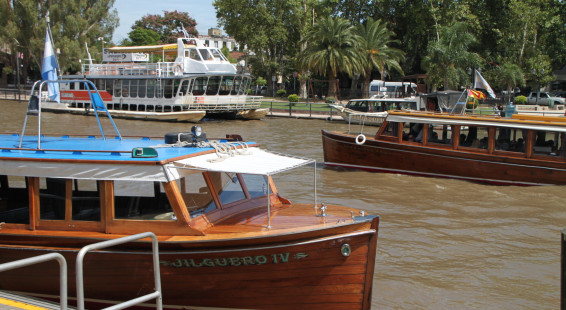
El Tigre is situated an hour’s train ride from Buenos Aires, a trip that will cost you less than US$1 (departs from the Retiro station — linea Mitro). You can also get there by taking a cab (more expensive but faster). We enjoyed the slower train journey and were treated to an interesting assortment of vendors, panhandlers, and train performers all plying their business. Trains sure are a great place to people watch.
We visited El Tigre as a day trip but I wished we’d stayed overnight so we could have explored the islands around it. The region is green and lush and built astride a river which was flooded when we visited (the Parana River is prone to flooding). El Tigre has a much slower pace of living than Buenos Aires and is a wonderful place to explore on foot. The area is called the Tigre region because of the jaguars that once hunted here (now mostly gone).
El Tigre is situated in the Parana Delta, an extensive 8,400 square-mile maze of river and rain-forest, with over one thousand islands. The Parana is the second largest river in South America, second only to the Amazon, draining an area larger than Greenland. The many channels of the river are somewhat reminiscent of canals, especially within the city as you can see from the photo at the top of this post. Boats constantly move about and rowing is a very popular sport.
In the late 18th century, Buenos Aires was under the grip of a yellow fever epidemic. The wealthier residents left the city to relocate upriver, first to Recoleta and Palermo, later to El Tigre (27 km from B.A.). The wealthy Argentenians built mansions and rowing clubs on the banks of the Parana River, Some of these homes (far from all) have been recently restored and the “gentile” charm of the town is evident. El Tigre was a remote place back then but now has almost been absorbed into the sprawl of greater Buenos Aires.
El Tigre is growing in popularity as a tourist destination. Besides visiting the city, which we’ll talk about in a minute, visitors take river cruises to meet the isleños—Tigre locals who live in houses on stilts and who do their grocery shopping on supermarket boats that travel from island to island. Lodges are available on some of these islands. The Parana Delta has become a popular bird-watching destination.

Club de Regatas La Marina, El Tigre. A rowing club that opened in 1927
Some of what we saw and did in El Tigre included:
1) Wandering along the Parana River, especially on Paseo Victoria. On a stretch of road just over a kilometer long we encountered sites many great cafes and restaurants, rowing clubs, and the Museo Naval de La Nacion. Housed in a mid 19th century structure, formerly a naval facility, this museum has exhibits of the Argentine naval history if that interests you.
2) The Museum de Arte Tigre (formerly a casino). Opened as a first rate gallery in 2006 after it was extensively remodeled, it’s an elegant structure as you can see below. Unfortunately it was closed the day we visited.

Casino, El Tigre. Now an art gallery
3) Avenida Lavale and the Museo del Mate. Mate is a tea-like beverage (though very different tasting) highly popular in southern South American. Mate has its own museum in El Tigre — nicely presented and run by friendly and helpful people. If you want to learn about Mate, this is the place to visit.

Puerto de Frutos, El Tigre
4) Puerto de Frutos. An old fruit market dating to a time when fruit production was the region’s main source of income. The market still sells fresh fruit from the islands but it’s transitioned to more of a flea market with lots of furniture and home decorating items. Some things are tourist oriented, but mostly the market is aimed at Argentinians as the items they sell are just to large to transport overseas. We’ll explore the market in a future post, but the following images offer some glimpses of its setting on the river and the merchandise being transported around it.
5) Families traveling with children might want to visit Parque de la Costa, a large amusement part (one of the largest in South America). It’s very popular with local kids but not at the standard of most American theme parks.
And for adults there’s a casino nearby if you get tired of the amusement park rides.
(Click on thumbnails to enlarge, right arrow to advance slideshow)